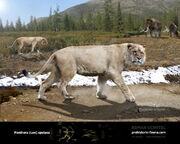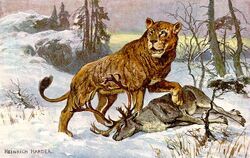| Panthera leo spelaea | |
|---|---|

| |
| An artist's interpretation of Panthera leo spelaea | |
| Scientific classification | |
| Kingdom: | Animalia |
| Phylum: | Chordata |
| Class: | Mammalia |
| Order: | Carnivora |
| Family: | Felidae |
| Genus: | Panthera |
| Species: | P. leo |
| Subspecies: | †P. l. spelaea |
| Trinomial name | |
| Panthera leo spelaea Goldfuss, 1810 | |
| Synonyms | |
| |
Panthera leo spelaea or P. spelaea, commonly known as the European or Eurasian cave lion, is an extinct subspecies of lion. It is known from fossils and many examples of prehistoric art.
Taxonomy

A restoration from the Prehistoric Fauna Website.
P. leo spelaea is sometimes considered a species in its own right, under the name Panthera spelaea, and at least one authority, basing his conclusion on a comparison of skull shapes, considered the cave lion to be more closely related to the tiger, which would have resulted in the formal name Panthera tigris spelaea. However, recent genetic research shows that among extant felids it was most closely related to the modern lion and that it formed a single population with the Beringian cave lion, which has been sometimes considered to represent a distinct form. Therefore, the cave lion ranged from Europe to Alaska over the Bering land bridge until the late Pleistocene. However, it is still not clear whether it should be considered a subspecies of the lion or rather a closely related species.
Analysis of skulls and mandibles of a lion that inhabited Yakutia (Russia), Alaska (United States), and the Yukon Territory (Canada) during the Pleistocene epoch suggested that it was a new subspecies different from the other prehistoric lions, Panthera leo vereshchagini, known as the East Siberian- or Beringian cave lion. It differed from Panthera leo spelaea by its larger size and from the American lion (Panthera leo atrox) by its smaller size and by skull proportions. However, recent genetic research, using ancient DNA from Beringian lions found no evidence for separating Panthera leo vereshchagini from the European cave lion; indeed, DNA signatures from lions from Europe and Alaska were indistinguishable, suggesting one large panmictic population.
Description

Cave Lion restoration by Heinrich Harder.
This subspecies was one of the largest lions. The skeleton of an adult male, which was found in 1985 near Siegsdorf (Germany), had a shoulder height of around 1.2 m (3.9 ft) and a head-body length of 2.1 m (6.9 ft) without the tail. This is similar to the size of a very large modern lion. The size of this male has been exceeded by other specimens of this subspecies. Therefore, this cat may have been around 8%-10% bigger than modern lions and smaller than the earlier cave lion subspecies Panthera leo fossilis or the relatively larger American lion (Panthera leo atrox). The cave lion is known from Paleolithic cave paintings, ivory carvings, and clay figurines. These representations indicate cave lions had rounded, protruding ears, tufted tails, possibly faint tiger-like stripes, and at least some had a "ruff" or primitive mane around their necks, possibly indicating males. Other archaeological artifacts indicate they were featured in Paleolithic religious rituals.
In 2008, a well-preserved cave lion specimen was unearthed near the Maly Anyuy River in Chukotka, Russia, which still retained some clumps of hair. A 2016 study identified the hair on the basis of DNA as being cave lion hair, and comparison to the hair of an African lion revealed that cave lion hair was similar in color to that of modern lions, though slightly lighter. In addition to slightly different coloration, cave lions had a very thick and dense undercoat comprising closed and compressed yellowish-to-white wavy downy hair with a smaller mass of darker coloured guard hairs, as an adaptation to the ice age climate.
Palaeobiology
These active carnivores probably preyed upon the large herbivorous animals of their time, including horses, deer, reindeer, bison and even injured old or young mammoths, which would have been killed by a powerful bite from the sharp teeth. Some paintings of them in caves show several hunting together, which suggests the hunting strategy of contemporary lionesses. Isotopic analyses of bone collagen samples extracted from fossils suggest reindeer and cave bear cubs were prominent in the diets of northwestern European cave lions. There was a suggestion of a shift in dietary preferences subsequent to the disappearance of the cave hyena. The last cave lions seem to have focused on reindeer, up to the brink of local extinction or extirpation of both species.
Distribution and habitat
P. leo spelaea populations were widespread in parts of Europe, Asia, and northwestern North America, from Great Britain, Germany, and Spain all the way across the Bering Strait to the Yukon Territory, and from Siberia to Turkistan. Panthera youngi reached to the Japanese Archipelago.
P. leo spelaea received its vernacular names because large quantities of its remains have been found in caves. It had a wide habitat tolerance, but probably preferred conifer forests and grasslands, where medium-sized to large herbivores occurred. Fossil footprints of lions, which were found together with those of reindeer, demonstrate the lions once occurred even in subpolar climates. The presence of fully articulated adult cave lion skeletons, deep in cave bear dens, indicates these lions may have occasionally entered dens to prey on hibernating cave bears, with some dying in the attempt.